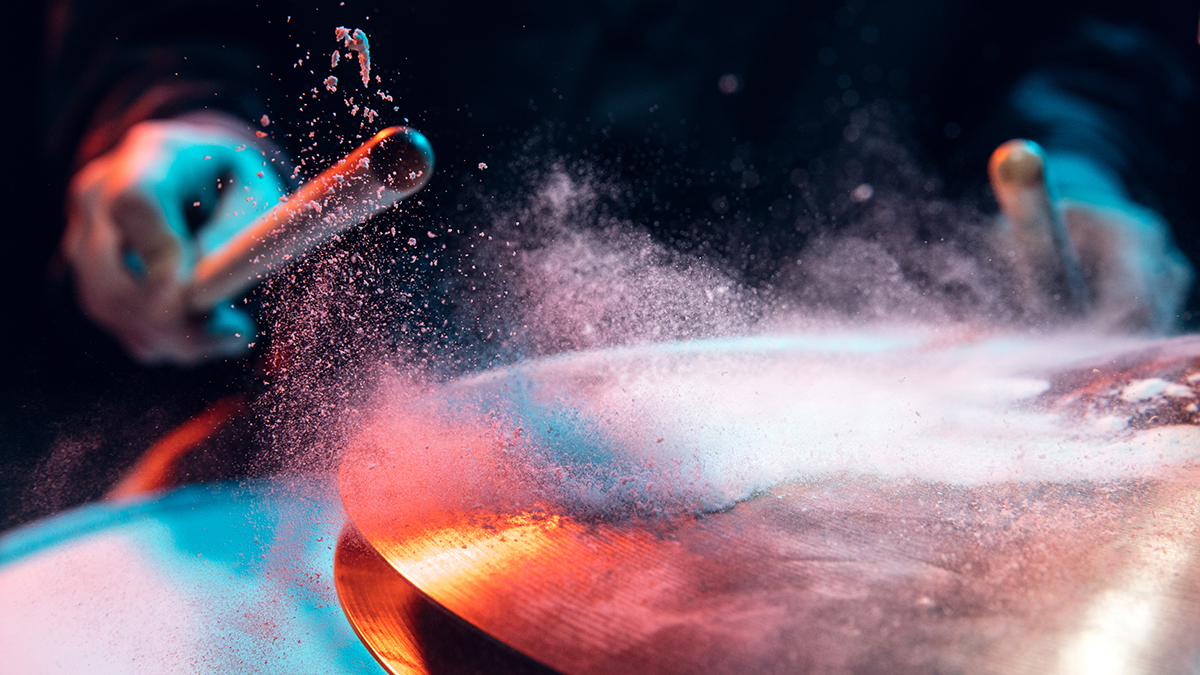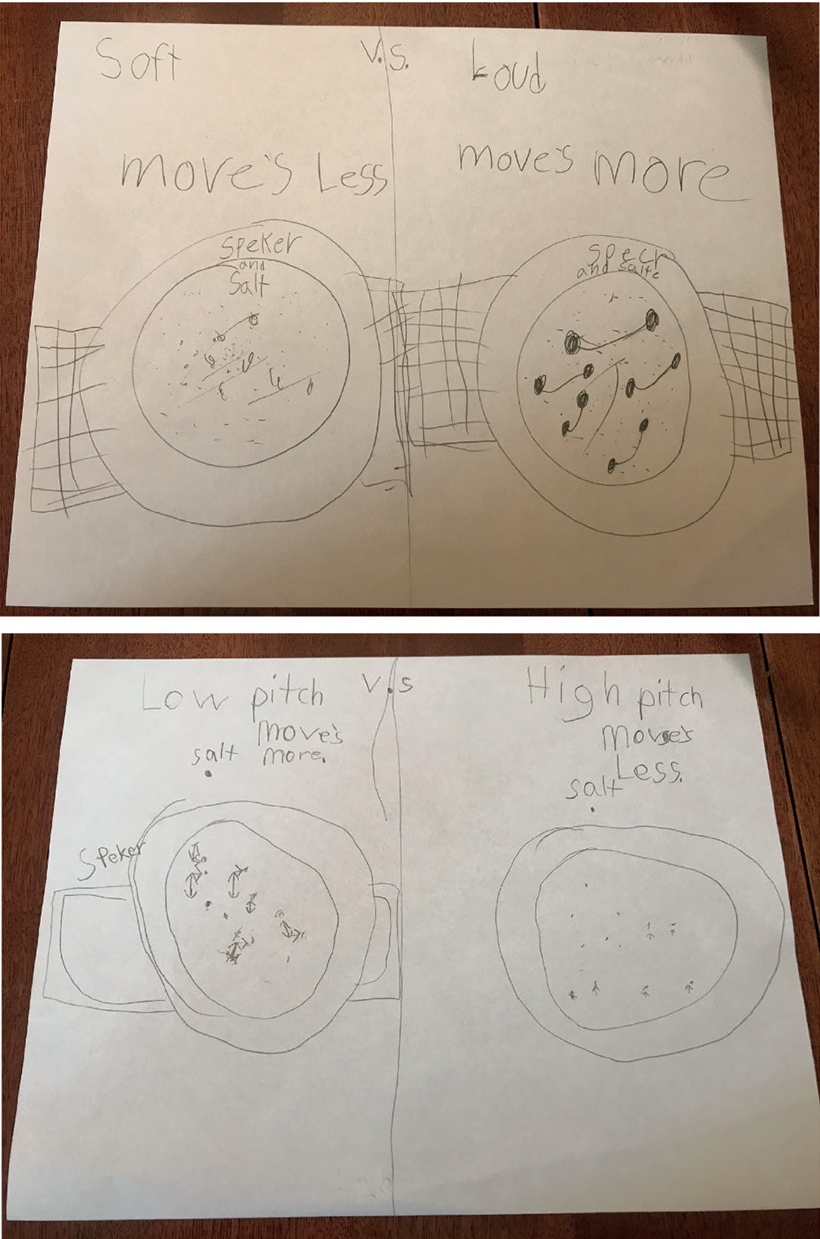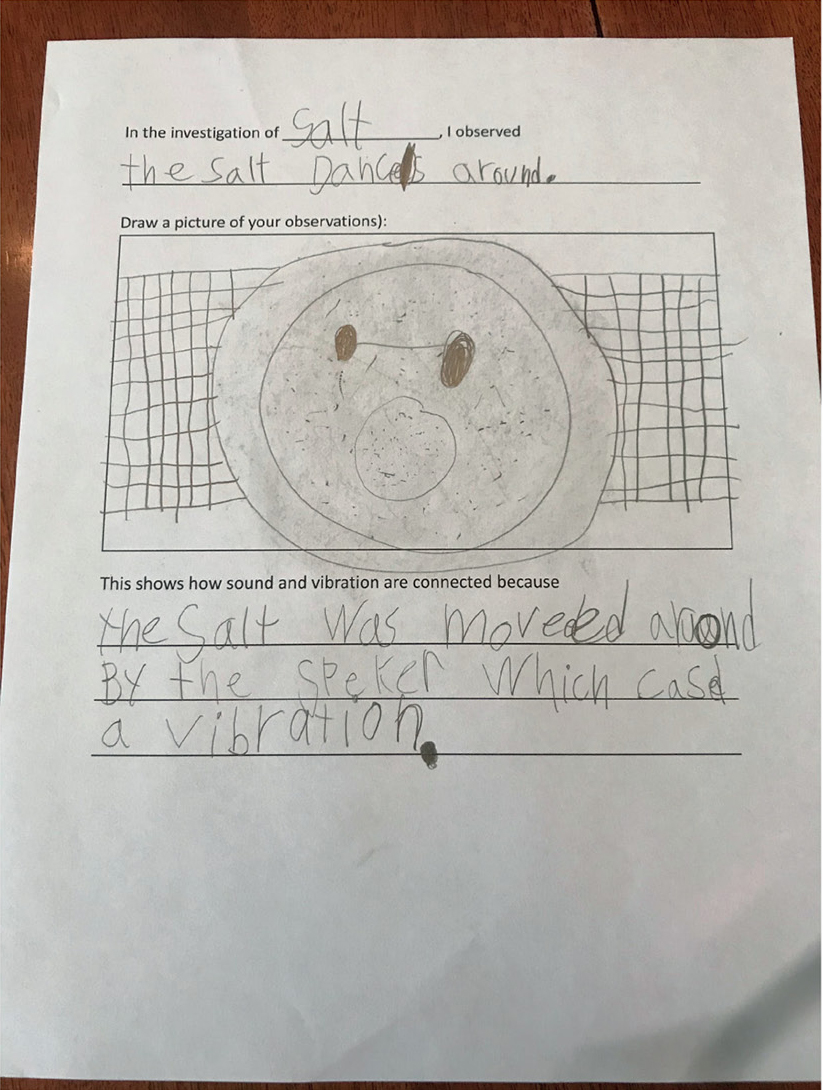feature
Come On Feel The Noise
Investigating sound and vibration in first grade with a nod to NOS
Science and Children—January/February 2023 (Volume 60, Issue 3)
By Ellen Gow, Jerrid Kruse, Susan Wees, Kristy Dee, and Leslie Hernandez

As an introduction to sound and vibration, we wanted our first-grade students to plan and conduct their own investigations. In this article, we share a series of investigations to help students explore the relationship between sound and vibration. By planning, creating, testing, adapting, and reflecting on the outcomes of the various investigations carried out, this lesson integrates inquiry-based science and the nature of science (NOS).
NOS refers to “what science is, how it works … how scientists operate as a social group and how society itself both influences and reacts to scientific endeavors” (Clough 2006, p. 463). We engage students in NOS by asking explicit and reflective questions (Abd-El-Khalick and Lederman 2000) that target specific NOS ideas to guide student thinking (Kruse et al. 2022; Voss, Kruse, and Kent-Schneider 2022) and include such discussions throughout the entire school year as short exposures are likely insufficient (Akerson, Morrison, and McDuffie 2006; Kruse 2008). That is, learning takes time (Kruse, Wilcox, and Easter 2022) and addressing NOS in only a few lessons is unlikely to help combat the many inaccurate messages students receive about how science works. The activities we share illustrate how we work to include NOS within content investigations.
Day 1
To begin, we wanted students to conduct investigations related to sound and vibration using sound through a speaker. For these investigations we used inexpensive small speakers (approximately $11 each) that can be plugged into the headphone jack of tablets. We asked, “What do you think would happen to salt if we put it on top of a speaker and played sounds through the speaker?” Students predicted, “It would fall off,” “It will move when sound is on,” and “It will stay still when sound is off.” Next, and to spark imagination in how students will execute their own procedures throughout the upcoming investigations, we asked, “What should we do to make sure that we do not damage the speaker with the salt?” Students easily noted precautionary actions such as: “Put it in a dish/bowl or cover the speaker.” We followed up by showing students a petri dish (or small plastic tub) and asked specifically, “How could we use this dish?” Students recognized that they could put the salt in the dish to keep it contained, then put the petri dish on top of the speaker to see what happens to the salt inside the dish, depending on what sound is, or is not, being played through the speaker (Figure 1).

Speaker-salt setup.
To consider general sound production, we asked, “How could we make sounds through the speaker?” Students typically said that we need to play music through the speaker. We explained that we want to control the sound a bit more, so we’ll be using a special app on the class tablets. We then demonstrated a few notes on the Moog App, although most any keyboard app will work. The Moog App shows a piano keyboard on the screen with various on-screen dials to adjust a wide range of sound properties. Students easily figure out how to make sound by touching the piano keys; we give them a few minutes to play with the various settings and dials. If you do not have access to tablets or digital technology, consider working with a music teacher to identify instruments that might be used to create sound and test for vibration.
To move from students playing with the app to “play with purpose” (Wilcox et al. 2022, p. 44), we asked, “What could we change about the sound to see how it affects the salt?” Students easily noted the volume but sometimes take a little longer to recognize that they can change the pitch as well. Next, and without too much direction, we give students a small vial with a small (tablespoon at most) amount of salt and their dish. We then encourage them to get started with their first sound and vibration investigation. We deliberately leave the entire planning and experiment process up to each pair. However, we walk around the room listening in, ask questions, and monitor for safety. As we walk around the room, we informally engage with the students to gain insight into what and how they are interpreting the connection between sound and vibration. Such informal check-ins enable us to immediately provide support and scaffold if students are struggling.
Throughout the first investigation, we noticed students gravitated towards testing “opposite” sounds. In other words, if students first tried a soft, low pitch, they often immediately used a strong, dramatic, high pitch to see a dramatic effect on the salt. When we observed this we asked, “So you changed both the pitch and the volume, how do you know which caused the change in the salt?” After some struggling, the students admit that they do not know. This cognitive dissonance is a great opportunity to explain the importance of changing only one variable at a time, and we highlight the importance of only changing one thing at a time to make a fair test. We also used such opportunities to begin discussing the notion of cause and effect by asking questions such as, “We call the change you made a cause and the result an effect. What was the effect of your change?”
We also noticed that some students naturally started to document their findings by drawing pictures—a very appropriate note-taking method for first graders (see Figure 2). When we noticed the note-taking/pictures, we addressed the whole class by asking, “I notice some of the groups are drawing pictures of the results, why do you think having some form of documentation is helpful for scientists?” Students typically explained that they wanted to remember what they saw and some even noted that scientists may have to share their results with others. We build on this NOS idea by asking, “Why do you think sharing and collaborating with other scientists is a good idea?”

Student drawings comparing effects of music on salt.
Day 2
Next, we wanted students to continue exploring sound and vibration but with a new medium. To review the previous day’s investigation, we asked our students, “How did the salt investigation demonstrate how sound and vibration are connected?” Students easily recalled the effects they observed, including: As the music (speaker) got louder, the salt moved more; the salt jumped; different pitches caused salt to move in different ways; and so on. Students were also eager to show and explain any notetaking and/or pictures they drew as they documented interesting observations.
For the second investigation, we eliminate salt and introduce a liquid. Students are encouraged to think about how they could use liquid to investigate sound and vibration. Students were also encouraged to think about how their process will be similar and/or different as they transition. Students naturally turned and talked to a partner about their predictions.
To facilitate the investigation while continuing to provide each pair autonomy when it comes to planning, creating, and executing their investigation, we: (1) ask students to share with their partner about what they will keep the same and what they will change while working with liquid instead of salt; (2) introduce and show the materials that will be available for the investigation; and (3) explicitly discuss the safety protocol associated with using water before allowing students to begin by asking students, “How can we prevent spilling of water?” and reminding students they need to be careful, keep the tablets away from the water, and tell a teacher about any accidental spills. After these introductions and reminders, we encourage students to get started on their investigation in pairs. To limit the potential spills, we limit the amount of water students have access to, providing each group with only enough water to just cover the bottom of their dish. While we have students use water for their investigations, we have noticed the vibration patterns to be more distinct with rubbing alcohol so we sometimes do a teacher demonstration using rubbing alcohol.
Explicit scaffolding was needed when we observed the students’ tendency to stick with one pitch. Not all pitches produce waves; therefore, we encouraged students to try a multitude of different pitches. You can do this by ensuring students work in pairs, with one student working on pitches while the other watches the dish carefully to avoid spills.
As we continued to observe each pair of students throughout the second investigation, we witnessed that the majority, if not all, students noticed a distinct difference between using salt versus liquid. While the salt bounced, the liquid vibrations showed up as various ripples and waves on the surface (Figure 3). Through trial and error, the students were able to identify various pitches that caused different patterns on the surface of the water.

Student drawings comparing effect on solid versus liquid.
After the investigation, we came back together as a whole group to discuss the findings of each pair. As expected, each pair’s findings varied slightly, serving as a natural topic for another NOS discussion: the role of observations and perspective in science. We asked, “You all noticed different things, why would two scientists notice different things?” Students made claims such as: Everyone has a different set of eyes and sees the world from their own perspective and people may be looking for different things. To push students further, we asked, “What is the benefit of having multiple people involved in an investigation?” Students recalled the value of working as a team and noted that sometimes one person might miss something.
Day 3
After students have some experiences with sound and vibrations, we sought to help students formalize this connection with a whole-group demonstration. To conduct the demonstrations, a ruler was held on a desk, with half of it hanging off the desk. Then, the half of the ruler hanging off the desk was struck using a demonstrator’s (teacher’s) hand. Students were asked to watch closely as the ruler was struck. To support creative inquiry, while staying mindful of the young age group of our students, we simply asked: “What did you notice?” Students typically note the ruler is moving, vibrating, making noise, moves back and forth fast, and so on. To help students connect sound and vibration more clearly, we ask, “Some of you noted the ruler is vibrating, and some said a sound was made. How do you think sound and vibrations are connected?” Students were able to claim that the vibrations of the ruler against the table make the sound. We then encourage students to connect these new observations to their previous investigations by asking, “How do you think what we observed with the ruler is like the salt and liquid investigations we did?” Students typically exclaim that the salt bounced like the ruler. To push them to connect the vibration to sound, we asked, “So, the bouncing helped us see the vibrations, how was sound involved with the ruler and the salt?” With this prompting, students often note that the ruler made a sound and the salt only bounced when the speaker was making sound.
As another example, we encourage students to put their fingers on their vocal cords and think about what they feel and hear as they talk. Students recognized that the louder they talk, the more vibration they feel as they track the vibrations of their vocal cords that vary depending on how loud they speak. We used this opportunity to build on previous small-group discussions concerning cause and effect by drawing a T-chart on the board labeled with “cause” and “effect” and asking, “What connection can you make between the vibration you feel and sound you hear?” When students noted that louder sound caused more vibration, we wrote “louder sound” in the cause column and “more vibration” in the effect column. We then asked students for more examples. Some examples students gave included: higher pitch caused less bouncing of salt, bouncing ruler caused drumming noise, and less loud caused smaller waves.
To promote understanding of NOS and, specifically, the idea that scientists do not all follow the same method, we ask, “We used different approaches to investigate, or study, sound and vibration, why do scientists use lots of different strategies?” Students claimed that more strategies lead to more information. We push students a bit further by asking, “Why would scientists sometimes follow a procedure or set of steps?” Students pretty easily recognize that if something has “been done before,” following a set of steps is a good idea.
Assessment
To evaluate each student’s understanding of the overall objective of this lesson, we ask them to reflect on the salt–speaker investigation and liquid–speaker investigation at the end of day 3. Students are asked to choose one of the investigations to explain their thinking about sound and vibration. We provide students with sentence frames to guide their thinking about what they observed and what claims they may have made regarding the connection between sound and vibration. To facilitate student understanding further, we ask them to also include a picture with their completed sentence frames. Based on students’ writing and drawings, we can determine if they understand the relationship between sounds and vibrations (see Figure 4). For example, when a student writes “the salt was moved around by the speaker, which caused a vibration” or “the sound is moving the liquid around,” we know students are making strong connections between sound and vibrations. Some students struggle to articulate their thinking in words, so we are sure to ask students to explain their drawings and thinking verbally as we circulate the room.

Assessment samples.
Of course, some students do not clearly connect sound and vibration in both directions. That is, students sometimes only explain how the sound caused the vibration of the salt or the liquid. Others only note the vibrations and do not clearly identify the relationship between sound and vibration. Importantly, our instruction on this standard is not complete with these investigations and we target the vibration-sound connection in future activities by having students investigate the different sounds they can make with various objects (e.g., rubber bands, springs, percussion objects).
Conclusion
In this lesson students work toward Next Generation Science Standard 1-PS4-1 by planning and conducting investigations to provide evidence about the relationship between sound and vibration. Through these investigations, students are acting and thinking like scientists as well as thinking about how science works. By engaging in scientific practices and learning about the nature of science, students are well positioned for future learning and engaged citizenship.
Ellen Gow is the assistant director for Kindercare Learning Center in Omaha, Nebraska. Jerrid Kruse (jerridkruse@gmail.com) is the Baker Professor of Education at Drake University in Des Moines, Iowa. Susan Wees is a third-grade teacher at St. Pius X in Urbandale, Iowa. Kristy Dee is a second-grade teacher at Baxter Community Schools in Iowa. Leslie Hernandez teaches English language learners at Monroe Elementary in Des Moines.
Inquiry Physical Science Three-Dimensional Learning Elementary


